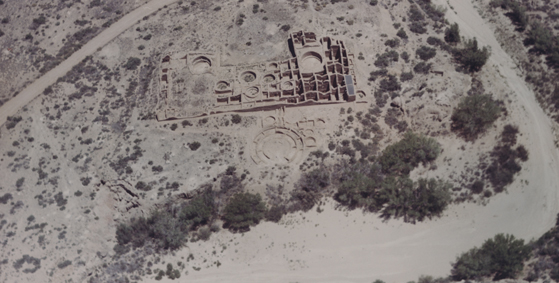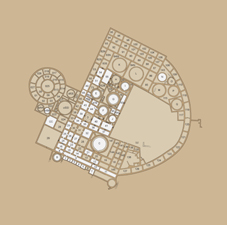Chaco Sites
Pueblo del Arroyo


Using this Map:
Click on the map image to launch full-size, interactive map.
When you select an individual room or kiva context on the larger map, a pop-up window will appear displaying information categories from our database available for that context (Artifacts, Burials, Tree-Ring Dates, and Features).
Each of the categories can be expanded by clicking the ‘+’ to reveal an abridged list of basic information. Selecting the category heading itself will open a separate window with complete details.
Site Description
Pueblo del Arroyo, whose name means “town by the arroyo” in Spanish, is a classic D-shaped great house located next to Chaco Wash about 900 feet (275 m.) west of Pueblo Bonito. It differs from other great houses in the canyon because it was not built near the northern cliff face and is oriented to the east rather than to the south. Due to its location, the site has been threatened in the past by erosion caused by floodwaters in the wash.
The great house originally stood up to four stories, and contained roughly 125 ground floor rooms. With approximately 300 total rooms and 17 kivas, it is the fourth largest of the Chacoan great houses. Construction occurred in discrete episodes, with initial activity occurring during the A.D. 1060s and additions into the first decades of the 12th century. After completion of the main roomblock, a tri-wall structure was added to the great house in the 1100s. While tri-walls occur at other sites in the Southwest (notably Aztec Ruins), Arroyo is the only structure in Chaco Canyon to have one.
Two excavations have been carried out at Pueblo del Arroyo. Neil M. Judd excavated about half of the great house and the associated tri-wall structure between 1923-1927 as part of the National Geographic Expedition. Leland Abel and Gordon Vivian of the National Park Service conducted the second excavation in 1950. The NPS project was initiated in part to salvage information about the tri-wall structure.
Alternate site designations include 29SJ1947 and LA 41947.
Excavation History
- 1923-1927: Excavated by Neil M. Judd of the National Geographic Expedition
- 1950: Leland Abel and Gordon Vivian of the National Park Service.
Size and Dates
- Approximately 300 rooms and 17 kivas
- Tree-ring dates indicate construction between A.D. 1060 and the early 1100s.
Site and Room Data
- Aztec West Ruins
- Bc 50 - Tseh So
- Bc 51
- Bc 53 - Roberts' Site
- Bc 57
- Bc 58
- Bc 59
- Chetro Ketl
- Pueblo Bonito
- Pueblo del Arroyo
- Shabik'eshchee
- Talus Unit #1
